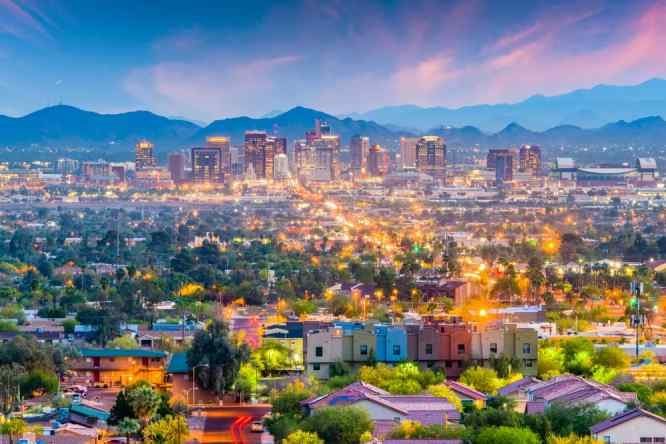
Phoenix Real Estate Statistics 2022-2021
The real estate market in Phoenix is strong this year, and it’s one of the best in the U.S. The COVOD-19 pandemic had slowed the market last year, but it has since recovered and picked up pace really fast. The housing market is extremely competitive, with property values experiencing exponential growth from last year. This trend is expected to continue heading into next year due to lower cost of living, growing, and available workforce. Here are Phoenix real estate statistics and facts.
• Median home value: $429,000
• Appreciation rate: +24.6%
• Median rent: $1,603
• Population: 1,680,992
• Unemployment rate: 6%
• Quality of life: 40th nationwide
• Crime index: 8.0
• Foreclosure rate: 1%
Phoenix Real Estate Facts 2022-2021
The Median Home Values in Phoenix
The median listing home price in Phoenix is $429 000 while the median sold home price is $400 000. This number represents a 24.2% growth from last year. Homes are selling faster this year compared to last year, taking an average of 28 days on the market. Homes are receiving multiple offers with hot properties selling up to 4% above the list price. The recent growth and increase in demand for houses is attributed to numerous buyers transitioning from urban apartments to suburban homes. Investors are also attracted to rental properties in the area. Source
Appreciation Rate
Phoenix has continued to experience a high home appreciation rate for the past decade. It has one of the highest appreciation rates in the country. The 1-year appreciation rate in Phoenix is +24.6%, while the projected rate for the coming year is +26.2%. There has also been an increase in luxury sales which further boosts the averages.
While most states also reported significant increases in appreciation rates, Phoenix joined a few other states that recorded double digits. The high rate of appreciation is also due to a short supply of housing units. There is an increased demand for housing units due to the increased population and not enough houses. Fewer housing units are being constructed compared to the rate of population increase. – Source
Phoenix Rent Statistics 2022-2021
The median rent in Phoenix is $1 603, while the rental vacancy rent is 6.3%. There is a growing rental market in Phoenix. One factor that has contributed to the rental market growth is the presence of universities. Phoenix is home to Arizona State University, among other campuses which host thousands of students. These students fill up the rental properties in Phoenix, with investors focusing on multi-unit buildings. Source
About 64% of households in Phoenix are occupied by owners, while 36% are rentals. With the increase in rents, more homeowners are opting to rent out their homes. The average rent for homes in specific neighborhoods in Phoenix is as high as $2 500 per month. The average rent for 1-bedroom apartments has increased by 23% from last year, standing at $1 250 per month.
Two-bedroom apartments experienced a 24% increase from last year to an average of $1 550. The average rent for three-bedroom apartments saw a 17% increase from last year, while four-bedroom apartments had a 21% increase.
Some of the cities that have experienced a fast rent growth from last year include Gilbert, Scottsdale, Glendale, Tempe, and Mesa. Other cities such as Garfield, La Mancha, and Papago Vista did not experience sharp rent increases from last year, making them affordable.
The number of Airbnb rentals and other rental sites has grown by 150% over the past five years. The state of Arizona passed a bill that simplified revenue collection leading to significant growth. Although the pandemic hit the sector hard last year, it remains resilient and is expected to rebound even stronger.
https://www.noradarealestate.com/blog/phoenix-real-estate-market/#Top_Reasons_To_Invest_In_The_Phoenix_Real_Estate_Market
Population Growth
According to the latest estimate by the US Census Bureau, the population of Phoenix is about 1 680 992. Phoenix has experienced steady population growth over the past decade. Some of the reasons that have contributed to the growth include the migration of families from California searching for affordable housing. There is also a huge number of retirees and an influx of tech companies.
The population in Phoenix has increased at a rate of 11.2% over the last ten years. The Phoenix metro area has over 4.9 million people and a per capita income of $34 074. The median household income is about $57 459.
Phoenix Job Statistics 2022
According to the Bureau of Labor Statistics, the unemployment rate in Phoenix is about 6%. There has been rigorous job growth over the past few years. The bureau also projects a 1.6% annual job growth by the end of the decade. Some of the industries showing signs of growth include hospitality, health services, education, and transportation. Others include logistics, cyber security, aerospace, and finance.
https://www.bizjournals.com/phoenix/news/2021/05/07/arizona-job-growth-to-outpace-nation.html
Quality of Life
Phoenix is ranked 40th best place to live due to the low cost of living, steady job market, and good climate. It also receives high scores for public schools, diversity, nightlife, and family living. With a cost of living that is 2% below the national average, Phoenix offers affordable healthcare, housing, and goods and services.
https://learn.roofstock.com/blog/phoenix-real-estate-market
Crime Rate
Phoenix has a crime index of 8.0, making it safer than most cities in the country. There are few violent crimes reported annually. Your chances of becoming a suffering a violent crime are one in 25. However, property crime rate is relatively high at 33 per one thousand population.
https://www.neighborhoodscout.com/az/phoenix/real-estate
Phoenix Foreclosure Facts 2022
The foreclosure rate in Phoenix is about 1%, representing one in every 9 607. During the first quarter of 2021, about 33 699 properties received foreclosure filings. The higher-end neighborhoods seem to be experiencing a higher rate of foreclosures. Source
The real estate market was faced with uncertainty and fear following the COVID-19 pandemic last year. Luckily, the government intervened by dropping interest rates to encourage people to buy. However, the low supply of housing units continues to increase demand and drive up prices

